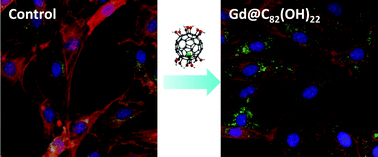Gd-Metallofullerenol nanoparticles cause intracellular accumulation of PDGFR-α and morphology alteration of fibroblasts†
Abstract
Gadolinium-metallofullerenols (Gd@C82(OH)22) are a promising agent for cancer therapy and have shown beneficial effects in regulating the tumor microenvironment with low toxicity. However, the underlying mechanism by which Gd@C82(OH)22 interacts with fibroblasts remains unclear. In order to explore the critical role that activated fibroblasts play in tumorigenesis and fibrosis, we investigated the regulatory effect of Gd@C82(OH)22 in fibroblast activation and oncogenic transformation, and found that the PDGFR-α is an essential molecule in modulating the morphology and functional changes in fibroblasts after Gd@C82(OH)22 treatment. Apart from increasing the PDGFR-α protein level, Gd@C82(OH)22 nanoparticles also significantly increased the protein level of Rab5, which is required for regulating PDGFR-α endosomal recycling. The Rab5-mediated recycling of PDGFR-α maybe attributed to the Gd@C82(OH)22 regulated inhibition of fibroblast activation. Overall, our work demonstrated that Gd@C82(OH)22 nanoparticles can attenuate the PDGF-stimulated phosphorylation of PDGFR-α in fibroblasts and suppress the fibroblast activation by interrupting endosomal recycling. These findings may be contributed to the collagen accumulation for encaging cancer.

- This article is part of the themed collection: Research selection from the NCNST


 Please wait while we load your content...
Please wait while we load your content...